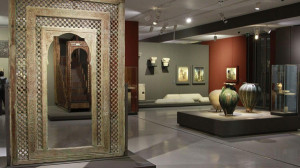Al Arabiya
The Associated Press
This photo taken March 4, 2015 shows a carved wooden medieval doorway from the Moroccan city of Fez dominating the exhibition room at the Mohammed VI Museum of Modern and Contemporary art in Rabat, Morocco. (AP)
With its imposing mountains, peerless beaches and medieval cities, Morocco has been a key tourist attraction for centuries, though few take the time to visit its tidy little capital Rabat unless on business.
Rabat, however, is making its mark on the cultural map, especially with the new King Mohammed VI art museum that until June 3 is hosting a wide-ranging exhibit on the art of medieval North Africa and Spain during the glorious years of Andalusia.
Right in downtown Rabat, the exhibit, which just came off a successful five-month stint at the Louvre in Paris, features 220 artifacts gathered from Moroccan mosques and dozens of European museums to illustrate an empire that stretched from Mali to central Spain during the Middle Ages.
There are detailed explanations of the period covered in French, Arabic and English and artifacts include ceramics, metal statues and stucco carvings painstakingly gathered together for the first time ever.
Carved wooden doors from schools in the royal city of Fez flank the entrance as viewers enter rooms filled with pulpits from mosques, the brass astrolabes that allowed the seas to be navigated and delicately carved ivory boxes made by Muslim craftsmen that later held holy relics in the vaults of European churches.
Museum director Abdelaziz Idrissi said it is a measure of the trust European museums have in Morocco that it was able to host such a varied and delicate collection of artifacts.
“At a time when internationally some are destroying their heritage, here in Morocco we are showing off the riches of our country,” he said.
The medieval Berber empires of Morocco were deeply influenced by their European and African neighbors as well as Christian and Jewish inhabitants.
The beautiful pieces in the exhibit, which are flanked by photographs of mosques and ancient schools in Morocco, are a timely reminder of the achievements of Islamic civilization.








